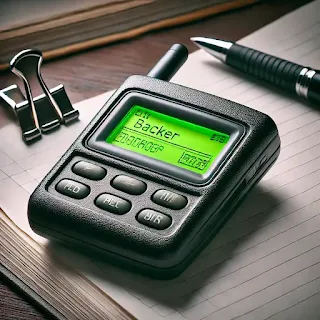Pager, a Telecommunication Device
A pager is a small wireless telecommunications device that receives and sometimes transmits messages. It was commonly used before mobile phones became widespread, especially from the 1980s to the early 2000s. Here's a detailed breakdown of how pagers worked and their key features:
Functionality
One-way Pagers: The most basic type, these only receive messages. Typically, they display a phone number or a short numeric message (numeric pagers). The user must call the number back using a landline or another phone.
Two-way Pagers: These could both send and receive messages, allowing users to engage in limited back-and-forth communication. Some models supported text messaging.
Types of Pagers
Numeric Pagers: Display only numbers, often used to show phone numbers that the pager's user should call back.
Alphanumeric Pagers: Can display both numbers and text messages, allowing for more detailed communication.
Voice/Tone Pagers: These alert the user with a beep or vibration when a message arrives, but the actual message is typically delivered verbally when the user calls a specific number.
Components
Receiver: The pager receives messages via radio signals sent over a specific frequency.
Display: Early pagers used LED or LCD screens to display the information received.
Alert System: Pagers notify users of incoming messages via beeps, tones, or vibrations.
Usage
Healthcare: Pagers were widely used by doctors and nurses due to their reliability, even in areas where mobile phone reception was poor.
Emergency Services: Police officers, paramedics, and firefighters relied on pagers to stay connected.
Business: Before mobile phones, business professionals used pagers to be reachable while away from landlines.
How Pagers Work
1. Message Transmission: A message is sent to a pager via a central paging terminal connected to telephone networks or internet services.
2. Radio Signals: The message is converted into a radio signal, which is broadcast over a specific frequency.
3. Pager Reception: The pager receives the signal and decodes it, displaying the message or alerting the user.
4. Coverage: Pagers typically had a wide coverage area, often spanning cities or regions, with dedicated paging networks ensuring reliable service.
Advantages
Reliability: Pagers were more reliable than early cell phones, particularly in areas with poor cellular coverage.
Battery Life: Pagers had long battery life compared to early mobile phones, sometimes lasting for weeks on a single battery.
Cost-Effective: They were cheaper to use than early mobile phones, especially for simple text or numeric communication.
Decline of Pagers
As mobile phones with SMS and mobile internet became ubiquitous, the demand for pagers sharply declined. However, they are still used in niche industries such as healthcare, where reliability and simplicity are valued.
Modern Usage
In some sectors, pagers are still favored for:
Hospital and Medical Professionals: Pagers have a strong signal reach, can operate inside buildings where mobile signals might be weak, and have secure, dedicated networks.
Disaster Response: Emergency responders may use pagers in scenarios where mobile networks are down or overloaded.




Comments